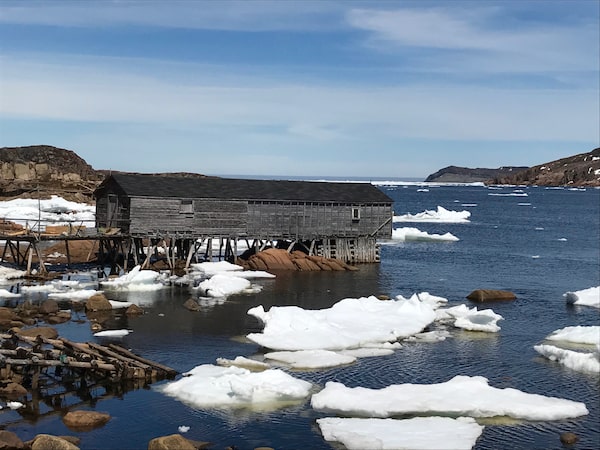
While the Fogo Island Inn put the remote locale on the map as a tourist destination, it has much more to offer.
A great auk stands stoically by the ocean at the end of a wild and windswept hiking trail, past a stunning artist residency studio, granite outcrops and rocky “beaches” set back from the water’s edge by geological changes. The extinct seabird couldn’t fly, but it bred on isolated islands near here, fed from the Atlantic and is immortalized at Joe Batt’s Point as a weathered bronze sculpture that people compulsively embrace.
On another edge of the island, the Brimstone Head hiking trail is shorter and steeper but has an equally eccentric finale. A map of the world nailed to a viewing platform boldly declares this to be one of the four corners of the flat earth, along with Papua New Guinea, the Bermuda Triangle and Hydra, Greece.
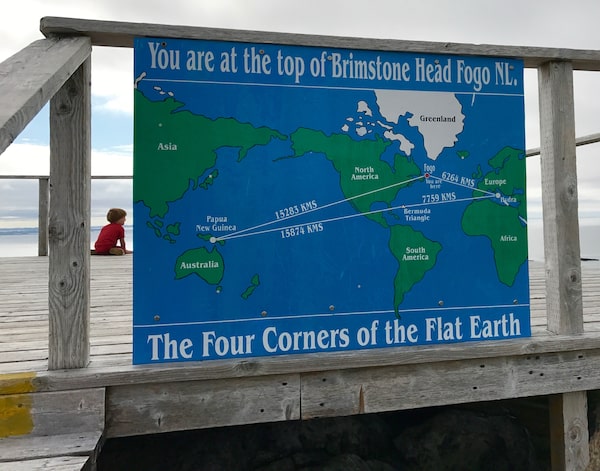
The Brimstone Head hiking trail purportedly leads to one of the four corners of the flat earth.
Fogo Island has strange powers. I impulsively bought a place here last year after briefly standing on the land, between the ocean and a rocky pond, in a ferocious rainstorm. This place forces you to connect and commit.
The Fogo Island Inn put this remote island-off-an-island on the world’s tourism radar, but please know there are roughly 2,200 people spread over 10 towns, hiking trails, an arts and craft community, a growing food scene, one supermarket, heritage properties and museums. There’s a resident herd of caribou, puffins, icebergs, whales, seals and the odd polar bear. There are shed parties, bonfires, lobster boil-ups, music festivals and punt boat races. There are more than a dozen places to stay, the cheapest being a campground with RV hookups, and the most expensive being the inn that turned this into an international arts destination.
“More people are starting to realize what Fogo is versus what they thought Fogo is,” Nick Wells tells me. He’s Fogo’s new director of tourism, culture and heritage and grew up elsewhere, but visited family here every summer.
“This has always been my very favourite place to be.”
One of my favourite Fogo quirks is something the inn made up – seven seasons instead of four. June 1 to 30 is “trap berth” season, a time to drop markers for cod trap fishing berths, and look for wildflowers, icebergs and whales. Summer’s coming, followed by berry season, late fall, winter, pack ice season and then spring.
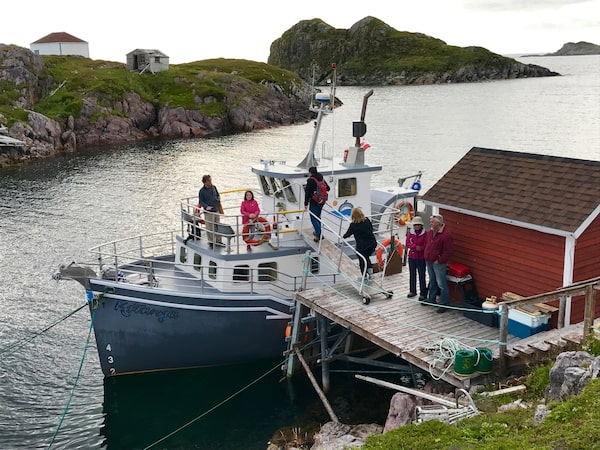
June has been dubbed ‘trap berth’ season, a time to drop markers for cod trap fishing berths.
From May to September, Ketanja Boat Tours runs trips to nearby Little Fogo Island, “the last rocks between here and Greenland,” captain Aneas Emberley says. “The wildlife that’s there is pretty interesting. The geology part of it is also awesome.” By wildlife, he means birds – puffins, bald eagles, razorbills, kittiwakes and turrs (murres). I saw my first puffins with Ketanja and was struck by how they looked like bowling balls flying low over the water.
Emberley sometimes adds cod fishing to trips that match up with the province’s recreational fishery dates. Cod is still king here, and when Newfoundlanders say “fish,” they mean cod. I’m partial to the cod bites at the Cod Jigger, a diner within a gas station that sells franchised fried chicken alongside partridgeberry tarts and bakeapple blossoms (another dessert). Wool hats and mittens are usually a smidge cheaper here than at the Wind and Waves Artisans’ Guild or the Fogo Island Shop, but those shops shouldn’t be missed.
I keep meaning to try Kwang Tung, the island’s lone Chinese restaurant. The Fogo Island Inn, meanwhile, has a new executive chef, Newfoundland-born Jonathan Gushue, best known for his time at Ontario’s Langdon Hall Country House Hotel and Spa. Hand line-caught cod from Fogo Island Fish is always served, and you might get a reservation if the inn isn’t full. What everyone is talking about, though, is how two sous chefs and their partners – who worked in marketing and as chef de partie respectively – have all left the inn to launch two restaurants.
“There’s so much greatness outdoors here, but not as many places inside to be together,” points out Ian Sheridan, who’s poised to open Bangbelly in the town of Fogo with Caitlyn Terry. The Dictionary of Newfoundland English defines “bangbelly” as a traditional fishermen’s dish made from old bread, salt pork, raisins and spice. The café will serve the day crowd baked goods and creative sandwiches, salads and soup. There will be an espresso machine and carefully sourced coffee and tea. There will be no deep fryer.
Over in Joe Batt’s Arm near the inn, Bryce Degner and Celina Parfitt have just opened Scoff – at 5:30 for supper seekers, before transforming into “late-night mode” for the after-work crowd. Supper, by the way, is the evening meal. “Dinner” means lunch.
Equal parts charming and frustrating is Fogo’s penchant for secrecy and indifference to signs. There’s idle chatter about a possible coffee shop in the outport town of Tilting and eager speculation about what the “refreshed” Growlers ice-cream shop will be like when it opens for the season under new management. It serves traditional and regional flavours and is named for the big chunks that break off icebergs.
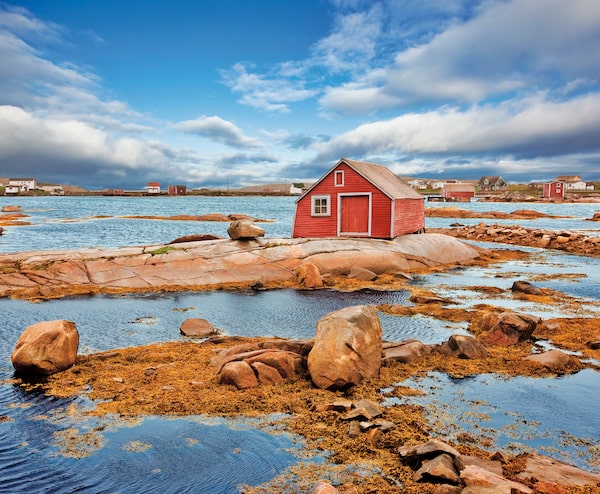
The outport town of Tilting is a National Historic Site.Wayne Barrett
I’ve driven around the Fogo Island Co-op plant but never figured out which door to go in to buy seafood. Apparently, there’s a fisher family that sells their catch in the town of Fogo – turn right when you get to town, follow the road to the end to a big wharf and red shed.
When I first visited Fogo, the inn’s community host, Blanche Bennett (now a lobby host), drove me down a seemingly desolate road to Herring Cove Art Gallery & Studio where Winston Osmond paints, crafts and tends to an impressive garden, his wife, Linda, makes quilts with Labrador tea leaf or salt cod patterns and they both make sensational jams.
“Fogo’s hot news these days,” announces Winston, who loves to chat, “but the perception that the island was nothing before the inn is false.”
Herring Cove’s neighbour is Fogo Island Metalworks and Marc Fiset has made a custom firepit and a puffin address plaque for our house, which incidentally is beside Young Studios, where artist Adam Young lives, paints and has a gallery.
Another artist, M’Liz Keefe, came from Boston for residencies in Tilting and stayed as a proud CFA (“come from away”). She fell in love with the island and with a visitor from British Columbia whom she met at the Fogo Island Partridgeberry Harvest Festival. Their home now doubles at the Joe Keefe Gallery, named in memory of Keefe’s late brother.
“It’s true – the island keeps things secret,” muses Keefe, who hosts occasional art showings and events and will answer knocks at the studio door, but hasn’t figured out how to best show and sell her art. She loves feeling like a pioneer here and needs Fogo’s quiet and solitude to paint her metaphorical landscapes, but doesn’t actually paint Fogo. “My oceans are just oceans. They’re a vehicle to get towards certain states of beauty or anxiety or places of the inner soul.”
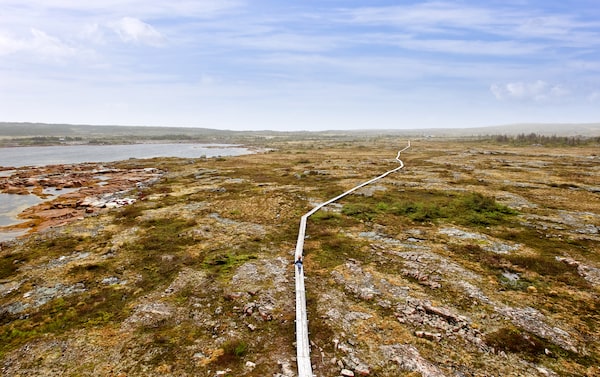
The island has a resident herd of caribou, puffins, whales, seals and the odd polar bear.Wayne Barrett
To uncover Fogo’s “secrets,” I scour the Fogo Island Events Group, Sell and Buy on Fogo Island and Fogo Island Ferry Updates groups on Facebook for leads on festivals, community suppers and church rummage sales.
Tilting, home to Irish settlers since the 1730s, is a National Historic Site. St. Patrick’s Day is a big deal and a September celebration of Irish/Newfoundland culture has an epic shed crawl. Al Dwyer leads Tilting walking tours, and Phil Foley hosts celebrities and regular folks at regular shed parties. Tom Earl’s Tilting Harbour B&B is steps from Phil’s Shed and grazing sheep. If you don’t stay with Earl, try for a seat at the former Toronto chef’s weekly family-style dinners featuring barbecued cod and vegetables from Winston’s garden.
Earl loves to send people to Riff’s department store, which is “kinda like a thrift store but everything is new” and is a quirky “33⅓ per-cent-off every day.” It’s next to the new Bangbelly, and “like a step back in time.”
My kids love Riff’s and the simple pleasure of Sandy Cove Beach. My husband loves the Flat Earth Coffee that Curtis Burns may or may not be serving on the Farewell to Fogo ferry. I love that multidisciplinary artist Kay Burns presides over a space that serves as Flat Earth’s café/roastery and the cheeky Museum of the Flat Earth.
Fogo hosts the cheeky Museum of the Flat Earth.
Kay is expecting three visiting artists to tackle a geological theme this summer – and to involve the public with events. Last year’s trio took a playful looks at the great auk, exploring the idea that it wasn’t wiped out by the feather trade in Europe and secretly lives on the other side of the flat earth.
That hike that I did to the great auk sculpture was led by Susan R. Eaton, a geologist visiting through the Shorefast Foundation, the non-profit that oversees international artist residencies at four studios (all worth hiking to), and runs the inn as a “geotourism” project that “sustains or enhances the distinctive geographical character of a place.”
So while there is more to Fogo than just one architecturally stunning hotel, that five-year-old inn is deeply woven into the fabric of the community. If you can’t stay at it, then walk up and photograph it, sign up for a tour, ask if there’s room to drop into the small lounge/bar, or book through OpenTable for the new afternoon “low tea.” Call and ask about free talks and other special events.
That’s right – call. Fogo is old school about communication. The chance to connect through the lost art of conversation is a big part of the island’s charm. Maybe Zita Cobb, the Fogo-born social entrepreneur behind Shorefast and the inn, says it best when she calls Fogo a “singular place.”
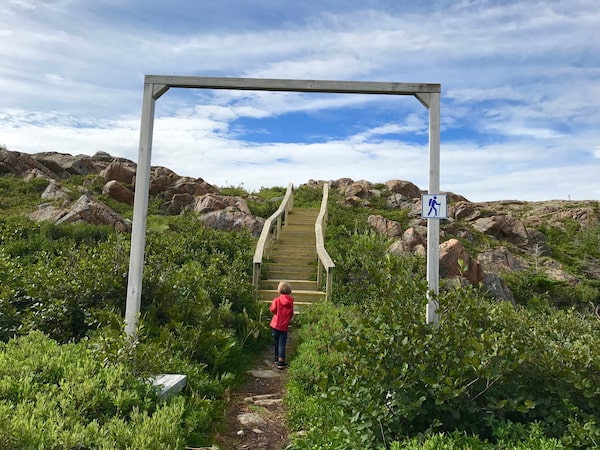
Hiking trails give visitors the chance to uncover Fogo’s secrets on foot.
Your turn
Get there by ferry: It’s about an hour’s drive from Gander, or roughly four hours from St. John’s, to the Fogo Island/Change Island ferry at Farewell. There are no reservations and the trip takes about an hour, depending on the season and route. There are multiple ferries a day, but the schedule changes frequently, so check the day before you go and be prepared to line up for spots, especially in summer.
Get there by air: EVAS Air Charters recently launched flights to Fogo Island from Gander, with tickets through westons.ca.
Get around: Most visitors rent cars and take the ferry to Fogo. There are no taxis, car rental companies or public buses on the island. Fogo Island Bus Tours offers ferry pickups and drop-offs for its full and half-day tours, and private tours and shuttles can be arranged.
Stay: Find accommodations at townoffogoisland.ca, which has been beefing up its information for visitors. Accommodations range from a campground with Rv hookups (costs from $15-$30) to small independent B&Bs and guest homes (rooms start around $100).